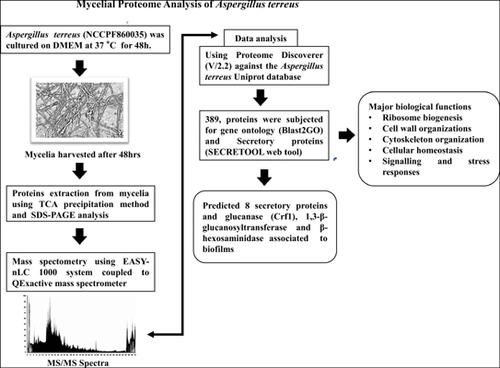Current Proteomics ( IF 0.5 ) Pub Date : 2020-09-30 , DOI: 10.2174/1570164617666191004163734 Sonia Kumari Shishodia 1 , Jata Shankar 1

|
Background: Aspergillus terreus is a major etiological agent among fungal pathogens and emerged as an opportunistic pathogen in immunocompromised patients.
Objective: To explore mycelial proteins to shed light on chemical and molecular details that contribute to pathogenesis including intrinsic resistant to amphotericin B (AmB), and biomolecules associated with biofilm formation.
Methods: The mycelial proteins of A. terreus cultured for 48h at 37°C have been analysed by using nLC-ESI-MS/MS. Protein data analysis performed by Proteome Discoverer (V/2.2) against the UniProt database. Also, Scanning Electron Microscopy (SEM) analysis of biofilm formation under optimum conditions was carried out. qRT-PCR was carried out for genes encoding for functionally important proteins.
Results: A total of 389 proteins were detected at FDR 0.01. Gene ontology showed the abundance of proteins from energy metabolism, cellular homeostasis, ribosome biogenesis, cell wall, and structural components. We observed catalase, superoxide dismutase, thioredoxin, glutathione S-transferase involved in redox homeostasis and heat shock proteins (Hsp90 and Hsp70). These proteins may provide insight into the resistance mechanism of A. terreus against AmB. Additionally, SEM analysis of A. terreus showed the formation of dense hyphal network covered with porous extracellular matrix (ECM). Using SECRETOOL, 8 proteins were predicted as secretory. Three proteins, such as glucanase Crf1/allergen (Asp F9), 1, 3-β-glucanosyltransferase and β-hexosaminidase were reported in biofilm establishment.
Conclusion: Our proteome data provided experimental evidence to the annotated set of proteins in A. terreus that comprehend biochemical and cellular events involved in the establishment of mycelial network and contributing to the pathogenesis. This work also provides resource for further molecular studies in A. terreus.
中文翻译:

曲霉揭示的核糖体生物发生和抗氧化酶的菌丝体蛋白的探索。
背景:曲霉是真菌病原体中的主要病原体,在免疫功能低下的患者中是机会病原体。
目的:探索菌丝体蛋白以阐明有助于发病机理的化学和分子细节,包括对两性霉素B(AmB)的内在抗性以及与生物膜形成相关的生物分子。
方法:采用nLC-ESI-MS / MS分析37℃培养48h的土壤曲霉菌丝体蛋白。Proteome Discoverer(V / 2.2)针对UniProt数据库执行蛋白质数据分析。另外,在最佳条件下进行了生物膜形成的扫描电子显微镜(SEM)分析。对编码功能重要蛋白的基因进行了qRT-PCR。
结果:在FDR 0.01下共检测到389种蛋白质。基因本体论显示了来自能量代谢,细胞稳态,核糖体生物发生,细胞壁和结构成分的大量蛋白质。我们观察到过氧化氢酶,超氧化物歧化酶,硫氧还蛋白,谷胱甘肽S-转移酶参与氧化还原稳态和热休克蛋白(Hsp90和Hsp70)。这些蛋白质可以提供对土壤曲霉对AmB的抗性机制的见解。此外,对土壤曲霉的SEM分析显示形成了覆盖有多孔细胞外基质(ECM)的致密菌丝网络。使用SECRETOOL,预测有8种蛋白是分泌蛋白。在生物膜的建立中报告了三种蛋白质,例如葡聚糖酶Crf1 /过敏原(Asp F9),1、3-β-葡糖基糖基转移酶和β-己糖胺酶。
结论:我们的蛋白质组数据为带注释的土壤曲霉蛋白提供了实验证据,这些蛋白理解了参与建立菌丝网络并促进发病机理的生化和细胞事件。这项工作也为进一步研究土曲霉提供了资源。











































 京公网安备 11010802027423号
京公网安备 11010802027423号